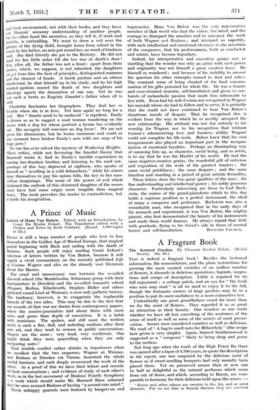A Fragrant Book
Tins is indeed a fragrant book ! Besides the technical information, the nomenclature, and the plain instructions for growing the most scented varieties of an endless number of flowers, it abounds in delicious quotations, legends, sugges- tions and scraps of description. Little is required for its full enjoyment : a cottage patch, and an eye for " the book who runs may read " is all we need to enjoy it to the full, though the fortunate owners of large gardens may be in a position to put its mere usefulness to a more exhaustive test.
Undoubtedly our great grandfathers cared far more than we for the scent of flowers. They regarded it as as great an attraction as their beauty. One wonders as one reads whether we have all lost something of the acuteness of the sense of smell as well as some of the secrets of scent preser- vation. Scents were considered curative as well as delicious. We read of " A bag to smell unto for Melancholy" (the recipe here given is very simple). Again, bruised Southernwood is suggested as a " composer " likely to bring sleep and peace to the restless.
Not long ago when the tomb of the High Priest Ra Ouer was opened after a lapse of 4,700 years, to quote the description in the report, one was surprised by the delicious scent of flowers as if sweet-smelling bouquets had only recently been placed there. Yet no preserved aroma then or now can be half as delightful as the natural perfumes which come from out of doors, and which, according to Bacon, are com- parable to harmony for their delicious hold upon the senses " Scents and other odours are sweeter in the Air, and at some distance. For we see that in Sounds likewise they are sweetest
when we cannot hear every part by itself. For all sweet smells have joined to them some earthly or crude odours and at some distance the sweet, which is the more spiritual, is perceived and the earthly reaches not so far."
Here is a charming piece of fancy taken at random :- " In the delicate sensitive eye of the primrose there is some- thing of almost human appeal. It is sweet and pure and childlike, thoughtful without a trace of sadness. Beyond
all this is the elusive other-world expression which always baffles us. We may look at them, but their eyes never meet ours."
The " faces " of primroses make us think of St. Bride, " the patron saint of the first flowers, young children and lambs. For February is the month of St. Bride of the kindly flame, the gentle mother of all young and tender things."
She is always represented with a lamp in her hand, " and on hillsides she brings the shepherds to the newborn lambs." We have quoted enough to show the quality of the book, which is of a piece throughout.



























































 Previous page
Previous page